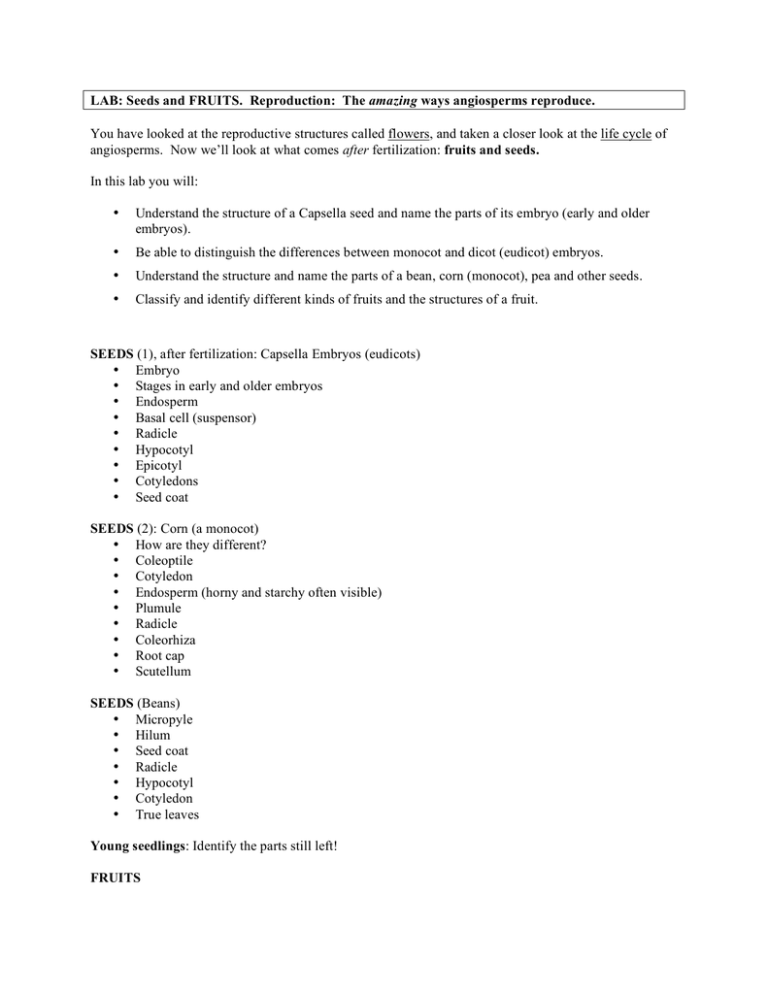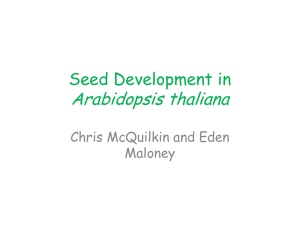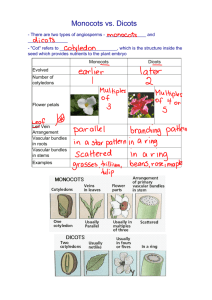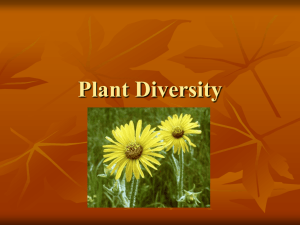amazing You have looked at the reproductive structures called flowers, and...
advertisement

LAB: Seeds and FRUITS. Reproduction: The amazing ways angiosperms reproduce. You have looked at the reproductive structures called flowers, and taken a closer look at the life cycle of angiosperms. Now we’ll look at what comes after fertilization: fruits and seeds. In this lab you will: • Understand the structure of a Capsella seed and name the parts of its embryo (early and older embryos). • Be able to distinguish the differences between monocot and dicot (eudicot) embryos. • Understand the structure and name the parts of a bean, corn (monocot), pea and other seeds. • Classify and identify different kinds of fruits and the structures of a fruit. SEEDS (1), after fertilization: Capsella Embryos (eudicots) • Embryo • Stages in early and older embryos • Endosperm • Basal cell (suspensor) • Radicle • Hypocotyl • Epicotyl • Cotyledons • Seed coat SEEDS (2): Corn (a monocot) • How are they different? • Coleoptile • Cotyledon • Endosperm (horny and starchy often visible) • Plumule • Radicle • Coleorhiza • Root cap • Scutellum SEEDS (Beans) • Micropyle • Hilum • Seed coat • Radicle • Hypocotyl • Cotyledon • True leaves Young seedlings: Identify the parts still left! FRUITS • • Pericarp o Exocarp (outside) o Mesocarp (middle) o Endocarp (inside) o Fleshy o Pomme (apple) o Drupe (cherry) o Berry (tomato) Pepo is a type of berry, eg. squash Hesperidium – modified berry eg. citrus • Dry, indehiscent (does not open at maturity) o Achene (sunflower) o Samara (maple) o Nut (pecan) o Grain (corn) • Dry, dehiscent (opens at maturity) o Legume (pea) o Capsella (shepherds purse) o Milkweed Aggregate fruit (blackberry, strawberry) Multiple fruit (pineapple, fig) Simple fruit Accessory fruit (strawberry and apple) – this just means that other parts of the flower besides the ovary are involved in making the fruit) • • • • Note how they are most likely dispersed: biotic or abiotic? By what mechanism I. The Developing Capsella embryo 1. Study the prepared slide of a cross section of the developing fruit of Capsella ("Shephard's Purse") labelled "before cotyledon" or "early embryo” and locate the ovary wall which contains the many developing seeds. Locate a seed cut to show the developing embryo (there may be many seeds in each section and not all show the whole embryo). A young embryo in the earliest stages of development is a ball of cells on the end of a short filament of cells which terminates in a large oval cell, the suspensor which is embedded in the nutritive tissue or endosperm of the young seed. Note the extent of the endosperm and identify the seed coats surrounding the embryo and nutritive tissue (endosperm). Locate a slightly older embryo which has more cells and is beginning to show two ear-like outgrowths which will become the cotyledons. 2. Study a prepared slide of a nearly mature embryo in a seed in a maturing ovary (ie. a fruit), and locate a section which shows a complete embryo bent into a U shape by its confinement in the seed coat. Locate the suspensor, the remains of the endosperm, the developing root near the suspensor, the embryonic root-stem system, the two large cotyledons and the small knob of apical shoot meristem between the base of the two cotyledons. The primary meristems can be located: the protoderm is the single layer of cells on the outside; the procambium runs up the center of the root-stem complex; and the ground meristem lies between the protoderm and the procambium. II. Mature Seeds 1. Select a bean seed which has been soaked overnight. Note the brown leathery outer seed coat; the hilum, a scar where the seed was attached to the mature ovary wall; and the micropile, a small hole at one end of the hilum. 2. With a dissecting needle, remove the seed coat and expose the embryo which is composed of the two large, fleshy cotyledons which take up most of the volume of the seed. Separate the cotyledons, and using a dissecting microscope, locate the rest of the embryo attached to one of the cotyledons. It has two small leaves, the epicotyl (between the leaves), the main axis or hypocotyl and the young root or radicle. 3. Examine soaked corn grains (each is a fruit rather than a seed because the thin ovary wall is fused to the seed coat) and on one of the flat sides you should see a slight oval bulge, this is the embryo. Remove the outer covering. The great bulk of the inside is filled with endosperm. Locate the embryo which has a single cotyledon embedded in the endosperm, and a short axis. The upper part of the axis is made up of the shoot apex and primary leaf which are covered by a sheath called the coleoptile. The lower part is made up of the radicle covered by a sheath, the coleorhiza. Try to cut through the axis and locate the structures inside the coleoptile and the coleorhiza. III. Seed Germination 1. In a young bean seedling, note the emerging primary root. 2. In an older seedling (six days or so) note the development of secondary roots from the primary root. The hypocotyl forms a "crook" or bend and as the seedling grows it straightens so eventually the epicotyl and two cotyledons are upright and the seed coat is split and drops off. 3. In a ten day (or so) seedling note the pale, shriveling cotyledons some distance from the ground. The hypocotyl has given rise to the lower part of the stem and root. The epicotyl has elongated to form the upper part of the stem bearing the first true leaves. IV. Fruits 1. Select a pea pod which is a fruit called a legume, and note the following: the pod itself consists of a single carpel that is folded longitudinally. Split the pod and note how the seeds are attached to one edge of the carpel. Study the seed. Can you locate a hilum? a micropyle? cotyledons? an embryo? Where was the flower? Think back to fertilization and try to locate the ‘parts’ where it happened. 2. Select an olive or plum or peach which are fruits called drupes. Look inside and note the ovary wall is differentiated into an outer thin, tough skin (exocarp), a fleshy middle layer (mesocarp) and a stony inner layer (endocarp). The seed is inside the stony layer. 3. Select an apple which is a fruit called a pome. It is said to be an accessory fruit because it is composed of tissues in addition to those that develop from the ovary. Cut the apple across (transversely) and find the five-lobed core containing the seeds. The inner wall of the ovary is tough and easily recognized; the outer layers are fleshy. Outside the fleshy ovary layers there is fleshy tissue derived from other floral parts. Can you determine where the two fleshy parts merge? 4. Using the key and vocabulary, classify the various fruits provided.





